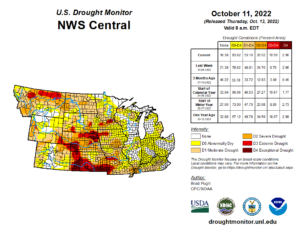Bloomberg's Leah Nylen reported Thursday that "a Colorado judge issued an order temporarily blocking the proposed $25 billion merger of Kroger Co. and Albertsons Cos., which has been challenged by…
Food Costs Up 11.2% Over Past Year, While Mississippi Water Level Worries Persist, and Russia Concerned About Black Sea Export Deal
Don Lee reported on the front page of today’s Los Angeles Times that, “That turkey you’re planning for the big family get-together is going to give you a nasty peck on the pocketbook. So will the flour for the gravy and the butter for the rolls.
“The latest government report on consumer prices, released Thursday, showed poultry prices are up a whopping 17% from a year ago. Flour is up 24%. Butter and margarine are up 32%.”

Lee pointed out that, “The annual inflation rate, at 8.2% in September, was just a notch below August and stayed near a four-decade high, the government said Thursday. And so-called core inflation, which excludes volatile food and energy items, hit a new 40-year high last month.”
Washington Post writer Rachel Siegel reported on the front page of today’s paper that, “The food index rose 0.8 percent in September, as it did in August. Fruits and vegetables were up 1.6 percent, and cereals and bakery goods were up 0.9 percent. Flour, turkey and butter hit new highs. All told, food costs are up 11.2 percent over the past year.”
September CPI, #Food at Home pic.twitter.com/4SyNPf0VzV
— FarmPolicy (@FarmPolicy) October 13, 2022
And New York Times writer Ana Swanson reported yesterday that, “Food inflation in the United States has remained stubbornly high this year, eroding the spending power of consumers and weighing heavily on lower-income Americans, who spend a greater proportion of their income on grocery bills.
🌪️🌪️Tornado chart of the change in average retail prices for many 🛒🛒#grocery items since January 2021 👇👇 @SenateAgGOP pic.twitter.com/qHLLcpIDJe
— John Newton (@New10_AgEcon) October 13, 2022
“Higher food prices are driven by a range of factors, including more expensive gasoline that farmers and grocers need to transport their products. Rising worker wages and prices for inputs like packaging and fertilizer have also driven up food costs, spilling over into higher prices at grocery stores.”
Hard to see on chart, but food component of September CPI #inflation improved slightly, up by 11.2% y/y vs. 11.4% in prior month … still near fastest rate going back near 1980s pic.twitter.com/U9pOORhkLk
— Liz Ann Sonders (@LizAnnSonders) October 13, 2022
Meanwhile, Bloomberg’s Brian K Sullivan reported yesterday that, “A drought is spreading across the US Midwest, drying up the Mississippi River and its tributaries that serve as a critical freight artery for the country.
“From Iowa to Ohio, nearly a third of the region is in drought, up from a quarter a week earlier, according to Thursday’s update from the US Drought Monitor. Parched conditions have also jumped in states bordering the Mississippi, like Arkansas, Tennessee, Mississippi and Louisiana.”
#Drought, North Central River Basin pic.twitter.com/bq2s3fyJQ5
— FarmPolicy (@FarmPolicy) October 13, 2022
Sullivan added that, “Dredging, or the removal of silt and other debris from river bottoms, has allowed vessel traffic to resume on some dried-up stretches of the Mississippi. Barge shipments on Midwest rivers jumped 105% from the previous week as of Oct. 8, the US Department of Agriculture said in a Thursday report.”
Low water conditions continue on the lower Ohio and lower Mississippi Rivers. Check out the table below and compare current river stages to past low water events. #MSriver #OHriver pic.twitter.com/AhN2J9XhhY
— NWS LMRFC (@NWSLMRFC) October 12, 2022
And Scott Dance reported in today’s Washington Post that, “The Mississippi River is flowing at its lowest level in at least a decade, and until rain relieves a worsening drought in the region, it’s becoming increasingly difficult to maintain water levels high enough to carry critical exports from the nation’s bread basket.

“Areas of persistent and developing drought stretch across much of the Mississippi basin, which itself covers 41 percent of the contiguous United States. Though record-setting storms caused catastrophic flooding in parts of the watershed this summer, the past few months have been among the driest on record in parts of the Heartland, at a time of year when river levels are normally hitting their low points. And long-term forecasts suggest that unusually dry weather is likely to continue.”
Percent of Normal Precipitation, September https://t.co/vsAMXrortM pic.twitter.com/7ydmie9MkT
— FarmPolicy (@FarmPolicy) October 13, 2022
Today’s article noted that, “The transportation industry says the intervention is needed to maintain a flow of exports that is central to the country’s agriculture industry. About 60 percent of U.S. corn and soybean exports move down the Mississippi, the Gulf Intracoastal Waterway and the Arkansas, Illinois, Ohio and Tennessee rivers, according to the U.S. Department of Agriculture.”
Dance added that, “Drought is pronounced across much of the country west of the Mississippi, including some two-thirds of the northern Plains states that drain to the Missouri River and then the Mississippi, U.S. Drought Monitor data show.”

Elsewhere, Reuters writer Emma Farge reported yesterday that, “Moscow has submitted concerns to the United Nations about an agreement on Black Sea grain exports, and is prepared to reject renewing the deal next month unless its demands are addressed, Russia’s Geneva U.N. ambassador told Reuters on Thursday.
“The agreement, brokered by the United Nations and Turkey in July, paved the way for Ukraine to resume grain exports from Black Sea ports that had been shut since Russia invaded. Moscow won guarantees for its own grain and fertiliser exports.”
Dow Jones writer Kirk Maltais reported yesterday that, “Wheat for December delivery rose 1%, to $8.97 a bushel, on the Chicago Board of Trade on Thursday, in response to reports that Russia will not renew the Black Sea grain export deal until its demands are addressed by the United Nations.”





